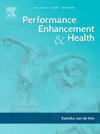菲律宾裔美国男大学生的适应、肌肉畸形症状和合成代谢-雄激素类固醇使用观念之间的关系:一项初步研究
IF 3.7
Q2 HOSPITALITY, LEISURE, SPORT & TOURISM
引用次数: 0
摘要
背景/目的由于社会文化因素,菲律宾裔美国人(FilAms)男性容易经历身体不满,但对该人群对肌肉和合成代谢雄激素类固醇(AAS)使用的态度知之甚少。本初步研究探讨了文化适应、肌肉畸形(MD)症状学和AAS概念之间的关系,并测量了来自单一机构的菲裔美国大学生的肌肉畸形症状严重程度。方法从某院校抽取210名FilAm男大学生进行在线调查。使用有效的量表(肌肉畸形障碍量表和菲律宾裔美国人短文化适应量表)测量肌肉畸形严重程度和文化适应。参与者还被问及AAS的使用理念和历史。结果研究发现,体型驱动和功能障碍与语言使用和偏好呈负相关,而外貌不耐受与语言使用和偏好呈正相关。39.0%的样本报告曾考虑使用原子吸收法。功能障碍和民族社会关系与AAS使用意念有密切关系。结论高MDDI和报告的AAS概念可以为制定针对FilAm男性的专门干预措施提供见解。本文章由计算机程序翻译,如有差异,请以英文原文为准。
Association between acculturation, muscle dysmorphia symptomatology, and anabolic-androgenic steroid use ideation in Filipino American male university students: A pilot study
Background/Objective
Filipino American (FilAms) males are prone to experiencing body dissatisfaction due to sociocultural factors, but little is known about the attitudes towards muscularity and anabolic-androgenic steroid (AAS) use in this population. This pilot study investigated the relationship between acculturation, muscle dysmorphia (MD) symptomatology, and AAS ideation, and measured the MD symptom severity level of Filipino American university students from a single institution.
Methods
A sample of 210 FilAm male university students from a single institution were recruited to complete an online survey. MD severity and acculturation were measured using validated scales (Muscle Dysmorphic Disorder Inventory and A Short Acculturation Scale for Filipino Americans). Participants were also asked about AAS use ideation and history.
Results
The findings showed that drive for size and functional impairment were negatively associated with language use and preference, while appearance intolerance was positively associated with language use and preference. 39.0 % of the sample reported having considered using AAS. Functional impairment and ethnic social relations were strongly associated with AAS use ideation.
Conclusion
The high MDDI and reported AAS ideation could provide insight into developing specifically tailored interventions for FilAm males.
求助全文
通过发布文献求助,成功后即可免费获取论文全文。
去求助
来源期刊

Performance enhancement and health
Social Sciences-Health (social science)
CiteScore
4.70
自引率
0.00%
发文量
27
审稿时长
57 days
 求助内容:
求助内容: 应助结果提醒方式:
应助结果提醒方式:


